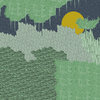Tenday Notes 22 March - 31 March 2021

Every ten days I share a quick digest of what I've been working on. Here's the latest. More in the series here. Want them in your inbox? Sign up.
If you're reading this, you're might already be aware of the existence of the Millennium Seed Bank - a vault in Kew Gardens in London, containing more than 2.4 billion plant seeds collected from around the world (there are many other seed banks around the world too).
Well, researchers have now discovered loads of kinds of fungi - some of which are likely to be totally new to science - stored inside those seeds. Turns out that the seeds in seed banks are themselves "incidental fungi banks", as the researchers put it.
The team looked inside the seeds of six different species of wild relatives of the banana, finding almost 200 new fungi species in the process. Some were able to be grown in their lab, while others were just detected by sequencing their DNA.
That's pretty amazing. But the researchers also found that each individual seed generally only contained a single fungal species. It seems like one will generally grow and outcompete any others. That's useful to know, because it could lead to us being able to innoculate a plant with a species that could outcompete another, more harmful one - essentially a natural form of disease control.
There's a lovely, readable account of the research mentioned above from one of the scientists who did it over on The Conversation. My favourite line:
Fungi are strange and cool and interesting enough that really all you have to do is share them and fascination will follow.

It's worth noting that in the wider world, researchers have found and described about 150,000 kinds of fungi. Which seems like a lot. But the latest estimate of the total number of fungi species on earth is actually 6.2 million. So we've barely scratched the surface of what's out there. Or I should probably say "in there", if we're talking about seed banks.
(A quick reminder that my partner runs a fungi newsletter called Filaments, which you should absolutely subscribe to if you want more if this kind of thing.)
"So your grandmother is a starship now: a quick guide for the bewildered."

I've been poking a little at Fraidyc.at, an aggregator you can use to follow people across whatever platform they prefer. You can tag people in different categories, and also set their importance to you - how often you want to check in on what they've been up to.
What I haven't done yet is actually set up very many people to follow yet. I wish there was a way for it to keep an eye on your behaviour and recommend people you check in on the most. Though that would undoubtedly require it to snoop on all kinds of activity that I'd be uncomfortable with.
In the meantime, though, it seems like a very nice way for me to follow folks on Instagram and Twitter without having to spend any more time than necessary on Instagram and Twitter, and also without having to be subject to the whims of the algorithm.
Terminal users will love tz - a tiny, interactive program that displays time across a few timezones of your choosing.
"I'm a short afternoon walk and you're putting way too much pressure on me".

I built a thing! With solder! And it works!
Specifically, I put together a quad random voltage generator from Transient Modules, over through course of a Zoom workshop put on by Exploding Shed. It's a synthesizer module that generates random voltages, but only when you give it a trigger. You can then use those voltages to alter the pitch, volume, and other sonic parameters of a piece of music. The triggerable quality means you can do it on a beat.

Buying synth kit gets kinda expensive quite fast, but building the modules myself brings a lot of advantages. It's cheaper, for one. It slows down the GEAR AQUISITION impulse, as I have to find time to get out the soldering iron and do a bit more work. And also it's fun and satisfying to make things myself - and a skill that I can use elsewhere. I've already repaired a broken bicycle light.
My next project is Tom Whitwell's "Control" - a set of four big knobs that you can use to control other modules. It's deliberately large - "human-sized" as Tom puts it in a blog post, rebelling against the trend of miniaturisation in modular synthesizers. Miniatuarisation is great, because it allows your rack to do more stuff in less space. But it's not always as pleasant to use as something larger, which gives more fine-grained control. I'm looking forward to building it, and eyeing up a 16N for afterwards.

Here's a good Twitter thread about the difficulties that scientists have communicating across disciplines because they use the same words to mean totally different things. Hilariously, one of those words is "standardisation".
One of the hardest parts of science communication is talking with scientists in other fields & it’s mostly because of what I like to call: “jargon homonyms”
— Dr Ellie Murray (@EpiEllie) March 28, 2021
These are words which look & sound the same, & have very specific technical meanings—but the meanings are *field-specific* pic.twitter.com/vvfQwikrBI
I've been enjoying listening to Gothenburg modular synth artist Elin Piel's album Omsorg. It's just the right blend of organic and synthetic.

I want to make some Loud Numbers t-shirts/stickers/etc that people can buy if they want to. More to spread the sonification love than to earn piles of cash.
What are the best sites to use so I can get the logistics handled for me, rather than having a big box of stickers and t-shirts in my house and sending them out myself? Any advice is welcome. Bonus points if they have some environmental cred!
Need a wiki-hole to fall down? Here's Aesthetics Wiki's list of aesthetics. Some of my favs include biopunk, dark naturalism, reefwave, plant mom, caninecore, and - of course - solarpunk.

Last year I did some work for a company called Ellipsis Earth that uses AI and drone technology to conduct surveys of beaches and other areas to find waste, litter, trash, plastics and so on.
This week, Ellipsis Earth founder Ellie Mackay invited me to talk about what I do as an information designer in a live event, aimed at an audience aged 8 to 18 and broadcast live to 49 schools around the world. You can watch the video on YouTube here - my bit starts at about 26 minutes in.
It was a fun session, which also featured amazing scientific mural artist Bryony Benge-Abbot. We covered what data visualization is, why it's important, how to decide what kind of chart to use, how to spot when a chart is misleading, and some top tips for getting started. There's also a Q&A at the end.
If you're looking for a resource to introduce school-age kids to data visualization and science communication, it might be useful?
Well this is amazing. Via Jeremy Singer-Vine's wonderful Data is Plural newsletter, here's a Twitter thread walking through an extremely high-definition map of world population density.
I've been talking a lot about million-point scatterplots and dot-density maps lately, so let me share a few previews of ultimate dot-density map--one dot, one person. I find these different images of settlement deeply fascinating... pic.twitter.com/cTICkgG3OE
— Benjamin Schmidt (@benmschmidt) March 10, 2021
I particularly love the images of the Nile delta, State planning in Mexico, Africa's great lakes, and the comparison between Tunisia (distributed rural) Libya (massive agglomeration) and Sicily (pointillist villages).
It doesn't cover Canada, Russia or China yet - too much land area. But you can download country level datasets for almost everywhere else from HDX.
Finally, I'll leave you with my favourite April Fools' joke of this year - South Australia Police dog operations' new "small area search and guided evacuation" dachsund team.
‼️New Dog Operations initiative announced‼️ The ‘small area urban search and guided evacuation’ dogs will be part of SAPOL's capabilities from today🐕🦺https://t.co/hpVfrqiXsd pic.twitter.com/OTFulWBAbg
— South Australia Police (@SAPoliceNews) March 31, 2021








